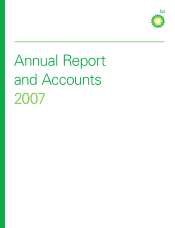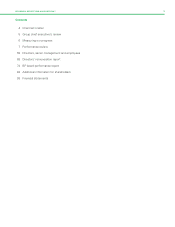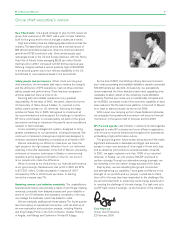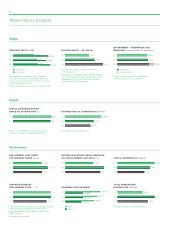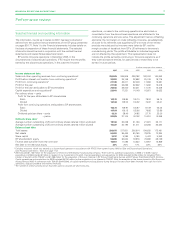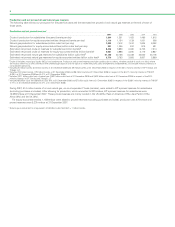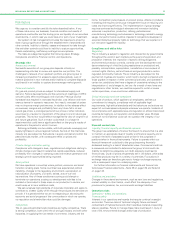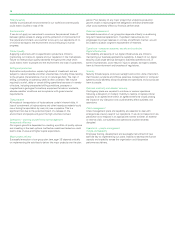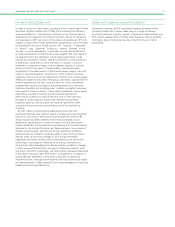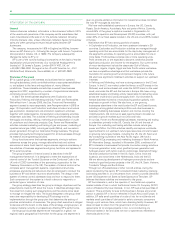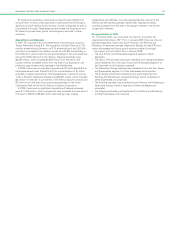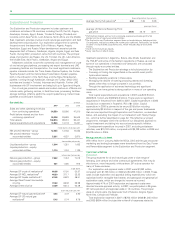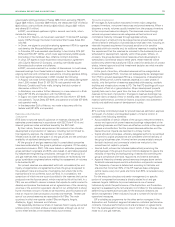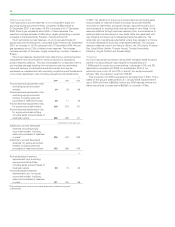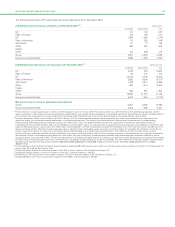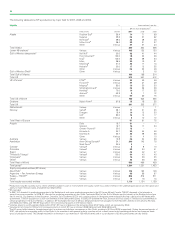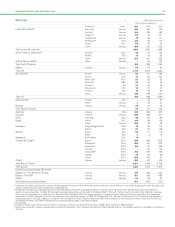BP 2007 Annual Report Download - page 11
Download and view the complete annual report
Please find page 11 of the 2007 BP annual report below. You can navigate through the pages in the report by either clicking on the pages listed below, or by using the keyword search tool below to find specific information within the annual report.
Risk factors
We urge you to consider carefully the risks described below. If any
of these risks occur, our business, financial condition and results of
operations could suffer and the trading price and liquidity of our securities
could decline, in which case you could lose all or part of your investment.
Our system of risk management provides the response to enduring
risks of group significance through the establishment of standards and
other controls. Inability to identify, assess and respond to risks through
this and other controls could lead to inability to capture opportunities,
threats materializing, inefficiency and legal non-compliance.
The risks are categorized against the following areas: Strategy;
Compliance and ethics; Financial control; and Operations.
Strategic risks
Access and renewal
Successful execution of our group plan depends critically on
implementing activities to renew and reposition our portfolio. The
challenges to renewal of our upstream portfolio are growing due to
increasing competition for access to opportunities globally. Lack of
material positions in new markets and/or inability to complete disposals
could result in an inability to capture above-average market growth.
Prices and markets
Oil, gas and product prices are subject to international supply and
demand. Political developments and the outcome of meetings of OPEC
can particularly affect world supply and oil prices. Previous oil price
increases have resulted in increased fiscal take, cost inflation and more
onerous terms for access to resources. As a result, increased oil prices
may not improve margin performance. In addition to the adverse effect
on revenues, margins and profitability from any future fall in oil and
natural gas prices, a prolonged period of low prices or other indicators
would lead to a review for impairment of the group’s oil and natural gas
properties. This review would reflect management’s view of long-term oil
and natural gas prices. Such a review could result in a charge for
impairment that could have a significant effect on the group’s results of
operations in the period in which it occurs.
Refining profitability can be volatile, with both periodic oversupply and
supply tightness in various regional markets. Sectors of the chemicals
industry are also subject to fluctuations in supply and demand within the
petrochemicals market, with consequent effect on prices and
profitability.
Climate change and carbon pricing
Compliance with changes in laws, regulations and obligations relating to
climate change could result in substantial capital expenditure, reduced
profitability from changes in operating costs and revenue generation and
strategic growth opportunities being impacted.
Socio-political
We have operations in countries where political, economic and social
transition is taking place. Some countries have experienced political
instability, changes to the regulatory environment, expropriation or
nationalization of property, civil strife, strikes, acts of war and
insurrections. Any of these conditions occurring could disrupt or
terminate our operations, causing our development activities to be
curtailed or terminated in these areas or our production to decline and
could cause us to incur additional costs.
We set ourselves high standards of corporate citizenship and aspire to
contribute to a better quality of life through the products and services we
provide. If it is perceived that we are not respecting or advancing the
economic and social progress of the communities in which we operate,
our reputation and shareholder value could be damaged.
Competition
The oil, gas and petrochemicals industries are highly competitive. There
is strong competition, both within the oil and gas industry and with other
industries, in supplying the fuel needs of commerce, industry and the
home. Competition puts pressure on product prices, affects oil products
marketing and requires continuous management focus on reducing unit
costs and improving efficiency. The implementation of group strategy
requires continued technological advances and innovation including
advances in exploration, production, refining, petrochemical
manufacturing technology and advances in technology related to energy
usage. Our performance could be impeded if competitors developed or
acquired intellectual property rights to technology that we required or if
our innovation lagged the industry.
Compliance and ethics risks
Regulatory
The oil industry is subject to regulation and intervention by governments
throughout the world in such matters as the award of exploration and
production interests, the imposition of specific drilling obligations,
environmental protection controls, controls over the development and
decommissioning of a field (including restrictions on production) and,
possibly, nationalization, expropriation, cancellation or non-renewal of
contract rights. We buy, sell and trade oil and gas products in certain
regulated commodity markets. The oil industry is also subject to the
paymentofroyaltiesandtaxation,whichtendtobehighcomparedwith
those payable in respect of other commercial activities, and operates in
certain tax jurisdictions that have a degree of uncertainty relating to the
interpretation of, and changes to, tax law. As a result of new laws and
regulations or other factors, we could be required to curtail or cease
certain operations, or we could incur additional costs.
Ethical misconduct and non-compliance
Our code of conduct, which applies to all employees, defines our
commitment to integrity, compliance with all applicable legal
requirements, high ethical standards and the behaviours and actions we
expect of our businesses and people wherever we operate. Incidents of
non-compliance with applicable laws and regulation or ethical misconduct
could be damaging to our reputation and shareholder value. Multiple
events of non-compliance could call into question the integrity of our
operations.
Financial control risks
Liquidity, financial capacity and financial exposure
The group has established a financial framework to ensure that it is able
to maintain an appropriate level of liquidity and financial capacity and to
constrain the level of assessed capital at risk for the purposes of
positions taken in financial instruments. Failure to operate within our
financial framework could lead to the group becoming financially
distressed leading to a loss of shareholder value. Commercial credit risk
is measured and controlled to determine the group’s total credit risk.
Inability to determine adequately our credit exposure could lead to
financial loss. Crude oil prices are generally set in US dollars, while sales
of refined products may be in a variety of currencies. Fluctuations in
exchange rates can therefore give rise to foreign exchange exposures,
with a consequent impact on underlying costs.
For further information on financial instruments and financial risk
factors see Financial statements – Note 28 on page 136 and Note 34
on page 143.
Liabilities and provisions
Changes in the external environment, such as new laws and regulations,
market volatility or other factors, could affect the adequacy of our
provisions for pensions, tax, environmental and legal liabilities.
Operations risks
Operations – safety and operations
Process safety
Inherent in our operations are hazards that require continual oversight
and control. There are risks of technical integrity failure and loss of
containment of hydrocarbons and other hazardous material at operating
sites or pipelines. Failure to manage these risks could result in injury or
loss of life, environmental damage and/or loss of production.
BP ANNUAL REPORT AND ACCOUNTS 2007 9

